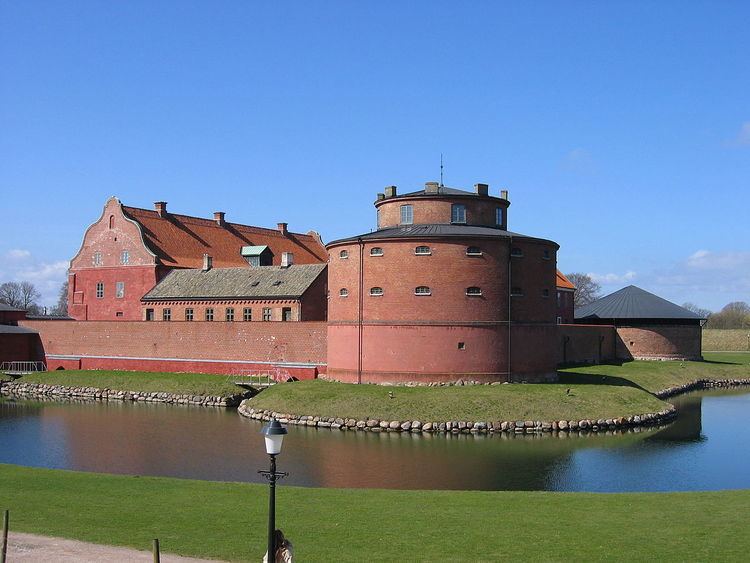Type Castle Phone +46 418 44 82 50 | Open tothe public By appointment Year built 1559 | |
 | ||
Hours Open today · 9AM–5PMSunday9AM–5PMMonday9AM–5PMTuesday9AM–5PMWednesday9AM–5PMThursday9AM–5PMFriday9AM–5PMSaturday9AM–5PM Similar Svaneholm Castle, Gråen, Glimmingehus, Sofia Albertina Church, Hjularöd Castle | ||
Landskrona citadell
Landskrona Citadel (Swedish: Citadellet or Landskrona slott) is situated in Landskrona, Scania, southern Sweden. Its entirety including the very well-preserved moat system, the castle, park and old allotment areas, and central as well as sea-side location makes Landskrona Citadel unique.
Contents
Of its original moat system, at its largest range, does both the fully around the castle surrounding moats remain. As well as the north-west and north-east parts of the most outer moat. To this comes an island which is totally surrounded by moats and around 250 meters of a moat that counted from the castle and outwards, must be considered as moat number three out of a total of four On the northern side of the caste, between the second, third and fourth moat does Sweden's oldest allotment-garden area resides. Several of its garden houses are attractions in themselves. Also the fortress castle itself hides both history as such as well as historical horrors, like the 16th Century dungeon in the old western tower, into which the unlucky prisoners were thrown down through a hatch. If surviving the 4-5 meter fall, there then was neither any daylight or any way out. Also the eastern tower has in later centuries served as a prison for lifetimers. And around 1900 until 1940 did a part of the fortress serve as a forced labour institution for vagrant women
Landskrona citadel fiske
History
Initially built by Christian III of Denmark 1549–1559 as a purely defensive fortification with two complete moats, the inner with a width of 70 metres (230 ft). The outer (complete) moat is between 40 and 70 metres (130 and 230 ft) wide, and has cross fire bastions for artillery and guns. Outside the outer moat, a third narrower moat covers the northwest and northeast. There also exist remains of a fourth moat (between the two outer moats). The fortifications and moats system surrounding the castle is known to be one of Europe's largest and best preserved. In the area between the outer and far outer moat resides the oldest area of allotment-garden cottages of Sweden.
It was briefly captured by the Swedes in 1644, but soon abandoned and returned to Denmark again. It became property of the Swedish King, in 1658 as a result of the Treaty of Roskilde. Between 1667 and 1675, the citadel was expanded with extensive bastions. On 2 August 1676, during the Scanian War, the commandant Hieronymus Lindeberg surrendered himself and the castle to a Danish army unit. And between 1676 and 1679, was the castle used as a center of command by the Scanian voluntary army corps ("Friskydter" in Danish-Scanian history, "Snapphanar" in Swedish) which fought together with the regular Danish army against the Swedish occupiers. Lindeberg survived the Danes but was later executed on order of Swedish king Charles XI of Sweden ("Karl XI"). During the Great Nordic War and the second Danish re-conqeust of Scania in 1711, did Landskona town soon come in Danish hands, but the Citadel was never taken by the Danish
In 1720 after a treaty commanded by France in Fontainebleu, became Scania, Landskrona and its Citadel for the first time official parts of Sweden (rather than a King's conquest). However in the peace treaty was Sweden subjected to live up to certain circumstances regarding Scania, which the Swedes cannot be said to have followed - at all. However, the latest peace treaty between Denmark and Sweden was signed a month after Fontainebleu, and is known as the Treaty in Stockholm of 3 July 1720. (Ratified in Denmark 3.July 1720).
In the middle of the 18th century, the local military commander feared (quite suddenly) that the 15th century church Johannes Babtistæ Kirke ("John the Baptist church"), which at the time was the second largest in Scania, must be destroyed. The reason was a fear for enemy canons in the church tower. The whole church was demolished and a new one, Sofia Albertina, was built some decades later. The castle was used as a women's prison from the late 19th century and some decades later. Today the castle is both a kind of museum (guided tours only, but not expensive, daily during the summer) and can be rented for private parties.
